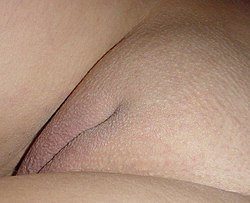Labium majus
| Labia majora | |
|---|---|

Labia majora and pudendal cleft
|
|
| Details | |
| Precursor | Genital swelling |
| Artery | Deep external pudendal artery |
| Nerve | Perineal branches of posterior femoral cutaneous nerve |
| Identifiers | |
| Latin | labium majus pudendi |
| Dorlands /Elsevier |
Labia majora |
| TA | A09.2.01.003 |
| FMA | 20367 |
|
Anatomical terminology
[]
|
|
The labia majora (singular: labium majus) are two prominent longitudinal cutaneous folds that extend downward and backward from the mons pubis to the perineum. Together with the labia minora they form the labia of the vulva.
The labia majora are homologous to the male scrotum.
Labia majora is the Latin plural for big ("major") lips; the singular is labium majus. The Latin term labium/labia is used in anatomy for a number of usually paired parallel structures, but in English it is mostly applied to two pairs of parts of female external genitals (vulva)—labia majora and labia minora. Labia majora are commonly known as the outer lips, while labia minora (Latin for small lips), which run alongside between them, are referred to as the inner lips. Traditionally, to avoid confusion with other lip-like structures of the body, the labia of female genitals were termed by anatomists in Latin as labia majora (or minora) pudendi.
Embryologically, they develop from labioscrotal folds. It means that they develop in the female foetus from the same previously sexually undifferentiated anatomical structure as the scrotum, the sac of skin below the penis in males.
The same process of sex differentiation concerns other male and female reproductive organs (see List of related male and female reproductive organs), with some organs of both sexes developing similar, yet not identical, structure and functions (like the gonads - male testicles and female ovaries, like male and female urethras, erectile corpus cavernosum penis and prepuce in the penis (foreskin) and the corpus cavernosum clitoridis in the clitoris and (clitoral hood) and their frenula). But other male and female sex organs become absolutely different and unique, like the internal female genitalia.
...
Wikipedia
